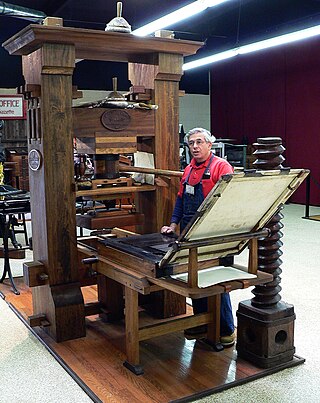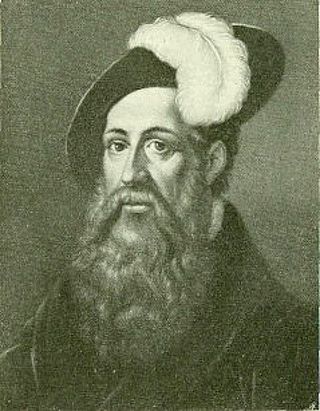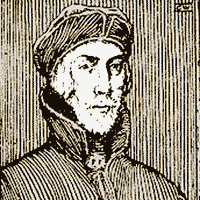
Arnold Pannartz and Conrad Sweynheym [1] were two printers of the 15th century, associated with Johannes Gutenberg and the use of his invention, the mechanical movable-type printing press.

Arnold Pannartz and Conrad Sweynheym [1] were two printers of the 15th century, associated with Johannes Gutenberg and the use of his invention, the mechanical movable-type printing press.
Arnold Pannartz was, perhaps, a native of Prague, and Conrad Sweynheym of Eltville near Mainz. Gottfried Zedler believed (Gutenberg-Forschungen, 1901) that Sweynheym worked at Eltville with Johannes Gutenberg in 1461–1464. Whether Pannartz had been connected with Sweynheym in Germany is not known. It is certain that the two brought Gutenberg's invention, the mechanical movable-type printing press, to Italy. Pannartz died about 1476, Sweynheym in 1477.
The Benedictine Abbey of Saint Scholastica in Subiaco (in present-day Lazio) was the cradle of Italian printing. Probably Cardinal Giovanni Turrecremata, who was Abbot in commendam of Subiaco, summoned the two printers there; they came in 1464. The first book that the Subiaco Press produced was a Donatus; it has not, however, been preserved. The first book printed in Italy that is extant is a Cicero, De oratore , which Pannartz and Sweynheim completed before 30 September 1465. [2] There followed Lactantius, De divinis institutionibus, in October, 1465, and Augustine's De civitate Dei (1467). These four impressions from Subiaco are of particular importance, because they abandon the blackletter of the early German books: Italian readers demanded Roman characters. Pannartz and Sweynheym, however, did not produce a pure but only a "half Roman" type with blackletter-like characteristics.

In 1467, the two printers left Subiaco and settled at Rome, where the brothers Pietro and Francesco Massimo placed a house at their disposal. That same year they published an edition of Cicero's letters that gave its name to the typographic unit of measurement named cicero, Continental Europe's equivalent of the pica typographic unit. [4] Their editorial director was Giovanni Andrea Bussi, at that time Bishop of Aleria in Corsica.
The works they printed are given in two lists of their publications, issued in 1470 and 1472. Up to 1472, they had published twenty-eight theological and classical volumes, namely, the Bible, Lactantius, Cyprian, Augustine, Jerome, Leo the Great, Thomas Aquinas, Cicero, Apuleius, Gellius, Virgil, Livy, Strabo, Pliny, Quintilian, Suetonius, Ovid, etc., in editions varying from 275 to 300 copies each – in all, 12,475 volumes.
The pair shared the fate of their master, Gutenberg; they could not sell their books, and fell into want. The Catholic Church took an interest in the expansion of printing during that time. In 1472, Pannartz and Sweynheim applied to Pope Sixtus IV for Church benefices. This application establishes that were ecclesiastics: Pannartz of Cologne and Sweynheym of Mainz. Sixtus had a reversion drawn up for them, a proof of his great interest in printing. In 1474, Sweynheym was made a canon at St. Victor at Mainz. It is not known whether Pannartz also obtained benefice. Perhaps the pope also aided them; at any rate, they printed eighteen more works in 1472 and 1473.
After this they separated. Pannartz printed by himself thirteen further volumes. Sweynheym took up engraving on metal and executed the fine maps for the Cosmography of Ptolemy, the first work of this kind, but died before he had finished his task.

Johannes Gensfleisch zur Laden zum Gutenberg was a German inventor and craftsman who introduced letterpress printing to Europe with his movable-type printing press. Though movable type was already in use in East Asia, Gutenberg invented the printing press, which later spread across the world. His work led to an information revolution and the unprecedented mass-spread of literature throughout Europe. It had a direct impact on the development of the Renaissance, Reformation, and humanist movements. All have been described as "unthinkable" without Gutenberg's invention.

Lucius Caecilius FirmianussignoLactantius was an early Christian author who became an advisor to Roman emperor Constantine I, guiding his Christian religious policy in its initial stages of emergence, and a tutor to his son Crispus. His most important work is the Institutiones Divinae, an apologetic treatise intended to establish the reasonableness and truth of Christianity to pagan critics.

A printing press is a mechanical device for applying pressure to an inked surface resting upon a print medium, thereby transferring the ink. It marked a dramatic improvement on earlier printing methods in which the cloth, paper, or other medium was brushed or rubbed repeatedly to achieve the transfer of ink and accelerated the process. Typically used for texts, the invention and global spread of the printing press was one of the most influential events in the second millennium.

Pope Paul II, born Pietro Barbo, was head of the Catholic Church and ruler of the Papal States from 30 August 1464 to his death. When his maternal uncle became Pope Eugene IV, Barbo switched from training to be a merchant to religious studies. His rise in the Church was relatively rapid. Elected pope in 1464, Paul amassed a great collection of art and antiquities.
This article is a list of the literary events and publications in the 15th century.

Johann Fust or Faust was an early German printer.

NicholasJenson was a French engraver, pioneer, printer and type designer who carried out most of his work in Venice, Italy. Jenson acted as Master of the French Royal Mint at Tours and is credited with being the creator of one of the finest early Roman typefaces. Nicholas Jenson has been something of an iconic figure among students of early printing since the nineteenth century when the artist William Morris praised the beauty and perfection of his roman font. Jenson is an important figure in the early history of printing and a pivotal force in the emergence of Venice as one of the first great centers of the printing press.
The Summa grammaticalis quae vocatur Catholicon, or Catholicon, is a 13th-century Latin dictionary which found wide use throughout Latin Christendom. Some of the entries contain encyclopedic information, and a Latin grammar is also included. The work was created by John Balbi, of Genoa, a Dominican, who finished it on March 7, 1286. The work served in the late Middle Ages to interpret the Bible. The Catholicon was one of the first books to be printed, using the new printing technology of Johannes Gutenberg in 1460.

Subiaco is a comune (municipality) in the Metropolitan City of Rome Capital, in the Italian region of Latium, 40 kilometres (25 mi) from Tivoli alongside the River Aniene. It is a tourist and religious resort because of its sacred grotto, in the medieval St. Benedict's Abbey, and its Abbey of Santa Scolastica. It is a member of the I Borghi più belli d'Italia association. The first books to be printed in Italy were produced here in the late 15th century.

The Ashendene Press was a small private press founded by St John Hornby (1867–1946). It operated from 1895 to 1915 in Chelsea, London and was revived after the war in 1920. The press closed in 1935. Its peers included the Kelmscott Press and the Doves Press. Hornby became friends with William Morris and Emery Walker, who helped inspire his work. These three presses were part of a "revival of fine printing" that focused on treating bookmaking as fine art. The Ashendene Press was famous for producing high-quality works by Dante. Ashendene books had excellent bindings and focused more on pleasure than reform than the other private presses of the time, though one review claims that the Ashendene Press was the most successful private press in recapturing the essence of fifteenth-century printing. Ashendene books were carefully printed with large margins, and despite their lack of extravagant decoration, they were considered spectacular works of art. Two original typefaces were created for the Ashendene Press: Subiaco and Ptolemy. They were known for handwritten, colored initials by Graily Hewitt. The press' main customers were book collectors who paid for a subscription for Ashendene books.

Peter Schöffer or Petrus Schoeffer was an early German printer, who studied in Paris and worked as a manuscript copyist in 1451 before apprenticing with Johannes Gutenberg and joining Johann Fust, a goldsmith, lawyer, and money lender.

Eltville am Rhein is a town in the Rheingau-Taunus-Kreis in the Regierungsbezirk of Darmstadt in Hesse, Germany. It lies on the German Timber-Frame Road.

Richard Pynson was one of the first printers of English books. Born in Normandy, he moved to London, where he became one of the leading printers of the generation following William Caxton. His books were printed to a high standard of craftsmanship, and his Morton Missal (1500) is regarded as among the finest books printed in England in the period.
The Subiaco Press was a printing press located in Subiaco, Italy. The Press was established in 1464 by the German monks Arnold Pannartz and Konrad Sweynheim in the Abbey of Santa Scolastica, Subiaco. Sweynheim had worked with Johannes Gutenberg, the inventor of the mechanical movable-type printing press. Making use of the invention, Subiaco Press was the first printing press in Italy.

Modern typographers view typography as a craft with a very long history tracing its origins back to the first punches and dies used to make seals and coinage currency in ancient times. The basic elements of typography are at least as old as civilization and the earliest writing systems—a series of key developments that were eventually drawn together into one systematic craft. While woodblock printing and movable type had precedents in East Asia, typography in the Western world developed after the invention of the printing press by Johannes Gutenberg in the mid-15th century. The initial spread of printing throughout Germany and Italy led to the enduring legacy and continued use of blackletter, roman, and italic types.

The brothers Johann and Wendelin of Speyer were German printers in Venice from 1468 to 1477.

Heinrich Eggestein is considered, along with Johannes Mentelin, to be the earliest book printer in Strasbourg and therefore one of the earliest anywhere in Europe outside Mainz.
Giovanni Andrea Bussi (1417–1475), also Giovan de' Bussi or Joannes Andreae, was an Italian Renaissance humanist and the Bishop of Aleria. He was a major editor of classical texts and produced many incunabular editiones principes. In his hands the preface was expanded from its former role as a private letter to a patron, to become a public lecture, and at times a bully pulpit.
Italy is the home of two of the world's biggest publishers of books in terms of revenue: Messaggerie Italiane and Mondadori Libri. Other large publishers include De Agostini Editore, Feltrinelli and the RCS MediaGroup.

Peter Schöffer the Younger was a German printer, the son of Peter Schöffer, a former apprentice of Johannes Gutenberg, and a grandson of Gutenberg's financier Johann Fust. He first worked in Mainz, where he set up his first workshop. He was an expert type caster, and his specialty was printing music. Schöffer moved to Worms in 1518, where he printed among other works the Tyndale Bible, which was the first mass-produced English edition of the New Testament, and the first complete German Protestant translation of the Bible. Later in life, he also worked in Straßburg, Venice and Basel.
Mentelin, the first Strassburg printer, used a gothic type which pointed towards roman in his Biblia Latina, finished in 1460. [...] But the font of the 'R Bizarre,' as it is often called, was the first roman letter used in Germany. [...] This ungainly roman type was used by Adolph Rusch of Ingweiden ('the R Printer'), who printed in it an edition of the Rationale of Durandus, at Strassburg, as early as 1464.
![]() This article incorporates text from a publication now in the public domain : Löffler, Klemens (1911). "Arnold Pannartz and Konrad Sweinheim". In Herbermann, Charles (ed.). Catholic Encyclopedia . Vol. 11. New York: Robert Appleton Company.
This article incorporates text from a publication now in the public domain : Löffler, Klemens (1911). "Arnold Pannartz and Konrad Sweinheim". In Herbermann, Charles (ed.). Catholic Encyclopedia . Vol. 11. New York: Robert Appleton Company.